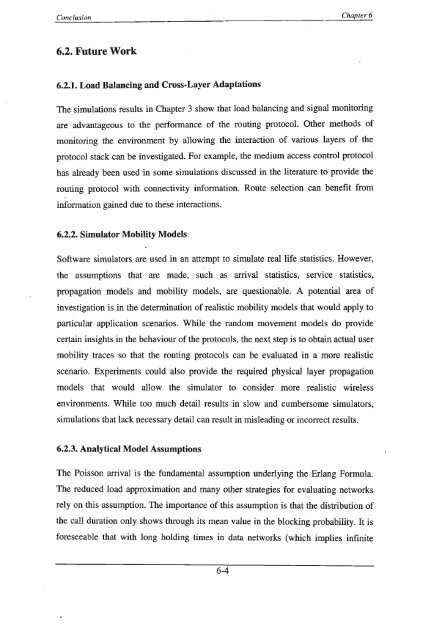Gugrajah_Yuvaan_ Ramesh_2003.pdf
Gugrajah_Yuvaan_ Ramesh_2003.pdf
Gugrajah_Yuvaan_ Ramesh_2003.pdf
Create successful ePaper yourself
Turn your PDF publications into a flip-book with our unique Google optimized e-Paper software.
Conclusion<br />
6.2. Future Work<br />
6.2.1. Load Balancing and Cross-Layer Adaptations<br />
Chapter 6<br />
The simulations results in Chapter 3 show that load balancing and signal monitoring<br />
are advantageous to the performance of the routing protocol. Other methods of<br />
monitoring the environment by allowing the interaction of various layers of the<br />
protocol stack can be investigated. For example, the medium access control protocol<br />
has already been used in some simulations discussed in the literature to provide the<br />
routing protocol with connectivity information. Route selection can benefit from<br />
information gained due to these interactions.<br />
6.2.2. Simulator Mobility Models<br />
Software simulators are used in an attempt to simulate real life statistics. However,<br />
the assumptions that are made, such as arrival statistics, service statistics,<br />
propagation models and mobility models, are questionable. A potential area of<br />
investigation is in the determination of realistic mobility models that would apply to<br />
particular application scenarios. While the random movement models do provide<br />
certain insights in the behaviour of the protocols, the next step is to obtain actual user<br />
mobility traces so that the routing protocols can be evaluated in a more realistic<br />
scenario. Experiments could also provide the required physical layer propagation<br />
models that would allow the simulator to consider more realistic wireless<br />
environments. While too much detail results in slow and cumbersome simulators,<br />
simulations that lack necessary detail can result in misleading or incorrect results.<br />
6.2.3. Analytical Model Assumptions<br />
The Poisson arrival is the fundamental assumption underlying the Erlang Formula.<br />
The reduced load approximation and many other strategies for evaluating networks<br />
rely on this assumption. The importance of this assumption is that the distribution of<br />
the call duration only shows through its mean value in the blocking probability. It is<br />
foreseeable that with long holding times in data networks (which implies infinite<br />
6-4
















